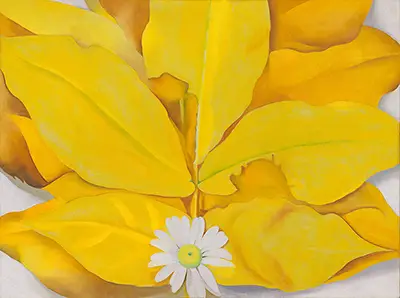The composition found in front of us here features several carefully placed leaves, with five main ones reaching out to the different corners of the canvas. The light strikes them hardest, making them slightly lighter than the remaining leaves that lie underneath and appear slightly more haphazard in their positioning. A single daisy is then placed at the foot of this plant, bringing in a flurry of white to set against the dominant yellow tones of the larger flower. The sizing is carefully planned so that we can see huge amounts of detail, but still understand what we are looking at. Other flower paintings were even more close up, but without any real context provided, as none of the edges of the plant were shown. Yellow Hickory Leaves with Daisy is therefore less abstract than those alternatives, but more accessible as a result.
Although this is technically a display of leaves rather than flowers, which is unusual for the artist, her finished design is still consistent, with good detail inserted into the piece as well as bright colour tones. She would select her flowers from her garden as well as local florists but we are not sure where the leaves of this Hickory plant came from. Research has revealed that she came across many beautiful leaves whilst walking close to Lake George and so the idea to use them in her work may have come from that period in her life. The different seasons have always inspired artists and leaves are particularly relevant to that, with colours changing as time moves ever onwards.
There was a deeper purpose to all of these natural depictions - by enlarging them way beyond their original sizes she hoped to force viewers into seeing these plants in new ways. One could not simply walk past with a quick glance when so much beautiful detail is thrusted at you, as well as with the bright tones used by the artist in her Modernist style. She would make use of a good variety of plants during the 1920s, constantly seeking new colours with which to add to her growing portfolio of flower and leaf paintings. In this example the bright yellow colours of the Hickory contrast delightfully with the light white daisy that is carefully placed at the bottom of the composition.

